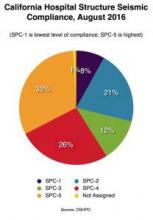OSHPD Offers New Seismic Compliance Option

California's Office of Statewide Health Planning and Development (OSHPD) has provided an opportunity for some of the state's older hospitals to find new ways to seek structural seismic compliance.
The agency has introduced a new category known as Structural Performance Category 4D, or SPC-4D. It joins five other categories of seismic compliance for buildings that provide acute care services.
The compliance levels include buildings built before 1973 that pose a significant risk of collapse in an earthquake (SPC-1) and buildings that may not repairable after a strong earthquake (SPC-2). Any building with a rating of SPC-3 or higher were mostly built after 1973 or 1989 and are considered to be seismically safe and can continue acute care operations after the year 2030. All hospital buildings have to be at SCP-2 levels by the end of this decade in order to continue offering acute care services.
“We really think this would be a good option for rural hospitals,” said OSHPD spokesperson Eric Reslock of the new designation, which would allow less extensive retrofitting work to take place on some structures where replacement would have previously been the only option.“These are frequently hospitals that have economic challenges and may not be able to get the financing to rebuild from scratch.”
Agency officials say the SPC-4D designation would mostly be aimed at retrofitting buildings that are currently categorized as SPC-2 structures or could be upgraded to SPC-2. They believe SPC-4D would primarily benefit hospital campuses with older buildings at their physical centers, possibly surrounded by structures with higher seismic rankings.
Any building that lies on or near a seismic fault, contains unreinforced masonry shear walls or precast concrete construction are not eligible for the SPC-4D designation, according to documents released by OSHPD.
Any retrofitting that occurs to meet the SPC-4D designation would need to be completed by January 1, 2030. Other than that, there are no other specific deadlines, according to the agency.
Despite the designation just being introduced, Reslock said five hospital operators have already applied for SPC-4D, although he was unable to immediately release names of those organizations.
The flexibility being offered by OSHPD comes after some two decades of drama surrounding seismic retrofitting. The hospital sector had complained that compliance would cost it tens of billions of dollars. There were also controversies regarding the use of the HAZUS program to assess the seismic state of many buildings. But state lawmakers and regulators have mostly been steadfast on the issue, pointing to hospitals that were severely damaged in the 1994 Northridge earthquake, and the extensive collapse of the VA Hospital and the Olive View Medical Center in the 1971 Sylmar earthquake. Forty-four patients lost their lives in the VA collapse; the Olive View structure had just opened for business six weeks before the temblor and did not reopen until the late 1980s.
Nevertheless, many of the state's largest hospitals and hospital systems have embarked on ambitious retrofit or upgrade projects in recent years. Among them are the construction of a new California Pacific Medical Center in San Francisco, a $2.1 billion project; and Stanford Hospital, a $2 billion project that includes another $3 billion in upgrades to the Lucile Salter Packard Children's Hospital and the Stanford University medical school.
In Southern California, replacement hospitals for UC Irvine and County-USC medical centers have already been built.
OSHPD data indicate most of the state's hospital buildings are now or will be seismically compliant by the end of this decade or by 2030. According to data released by the agency earlier this week, 91% of the state's acute care hospital structures no longer pose a risk of collapse in a serious earthquake. There are only 251 at-risk structures statewide as of last month, compared to more than 1,300 in 2002. Currently, 70% of acute care hospital buildings are classified as SPC-3 or higher.
Reslock suggested that the high compliance rate of so many hospitals years before they were required to do so allowed OSHPD to be more flexible for new seismic upgrades. But he added that the next decade-and-a-half will also pose challenges for those hospitals straining to comply with the 2030 deadline.
“We're just doing what we can,” he said.






